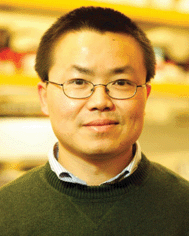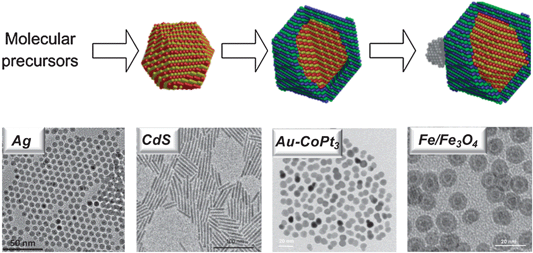The chemistry of functional nanomaterials†
Yadong Yina and Dmitri Talapinb
aDepartment of Chemistry, University of California, Riverside, CA 92521, USA. E-mail: yadong.yin@ucr.edu
bDepartment of Chemistry, University of Chicago, Chicago, IL 60637, USA. E-mail: dvtalapin@uchicago.edu
Abstract
Nanostructured materials are the core components of nanotechnology, providing basic building blocks for fabricating complex devices with desired functions. Thanks to their inherent quantum size and shape effects, nanomaterials have many important applications in electronics, optoelectronics, information processing, catalysis, biomedical science, environmental science, energy conversion and storage, advanced defense technologies, and many other fields. Chemistry plays a central role in the development of novel nanostructured materials. This themed issue on the chemistry of functional nanomaterials gives a broad overview of the synthesis, structural manipulation, characterization, surface modification, self-assembly, processing and integration of nanoscale materials into functional devices.
 Yadong Yin | Yadong Yin received his PhD in Materials Science and Engineering from the University of Washington in 2002, then worked as a postdoctoral fellow at the University of California, Berkeley and the Lawrence Berkeley National Laboratory, and became a staff scientist at LBNL in 2005. In 2006 he joined the faculty at the Department of Chemistry at the University of California, Riverside. His research interests include the synthesis and application of nanostructured materials, self-assembly processes, and colloidal and interface chemistry. |
 Dmitri Talapin | Dmitri Talapin received his doctorate degree in Chemistry from Hamburg University in Germany under the supervision of Horst Weller. He then was a postdoctoral fellow at IBM T. J. Watson Research Center in 2003–2005 and a staff scientist at the Molecular Foundry at Lawrence Berkeley National Laboratory in 2005–2007. He joined the faculty at the University of Chicago in 2007. His current research interests include synthesis of inorganic nanostructures and their device integration, with the desire of turning colloidal nanostructures into useful materials for electronics and optoelectronics. |
Synthesis of inorganic nanomaterials: from semiconductor quantum dots to chiral nanostructures
The synthesis of nanomaterials has emerged as an important branch of synthetic chemistry. Various techniques have been developed to control composition, size, shape and surface chemistry of different nanomaterials and tailor their properties for particular applications. In many cases, the synthesis starts with appropriate molecular precursors and proceeds toward more and more complex nanostructures as shown in Fig. 1. Several review articles in this themed issue cover different aspects of chemistry used in synthesis of metal and semiconductor nanomaterials. | ||
| Fig. 1 (top) Nanomaterial synthesis often starts with simple molecular precursors that undergo chemical transformation into nanoparticles that can be further transformed into complex nano-heterostructures. (bottom) Several examples of nanomaterials with different shape and composition. | ||
The great interest of the research community in nanomaterials in the past three decades has been stimulated by the development of colloidal semiconductor nanocrystals, more often called quantum dots, which exhibit well-defined quantum size effects and open up bright prospects for widespread applications. Kershaw and co-workers (DOI: 10.1039/C2CS35331H) provide a comprehensive review on the colloidal synthesis, film processing, and composite material fabrication of nanocrystals, with a particular focus on narrow bandgap chalcogenide materials that absorb and emit light in the infrared spectral region. Some important applications of these nanostructured materials are also discussed, including solar energy harvesting and conversion, infrared optoelectronics, and biological imaging and biosensing. Most high quality colloidal quantum dots are produced by the so-called “hot injection” method, which involves rapid thermolysis of precursors in the presence of organic capping ligands. Being hydrophobic, for biological applications, they often need to be transferred to the aqueous phase through post processing such as ligand exchange. Eychmüller et al. (DOI: 10.1039/C2CS35285K) discuss the main achievements and challenges in the direct synthesis of semiconductor quantum dots in aqueous colloidal solutions. In addition to compatibility with biological media, aqueous approaches are also advantageous in many aspects, such as simplicity, versatility, scalability, environmental friendliness and cost effectiveness. Motivated by their technological importance, Schaak and Vaughn (DOI: 10.1039/C2CS35364D) highlight the progress in the colloidal synthesis of size- and shape-controlled germanium nanomaterials and their potential applications in optoelectronics, biological imaging, and energy conversion and storage. The discussion has also been extended to the colloidal synthesis of other germanium-containing compounds, especially technologically relevant germanium chalcogenides, including GeS, GeSe, and GeTe. Targeting in particular their applications in energy conversion and storage, Yu and co-workers (DOI: 10.1039/C2CS35310E) also provide a summary on the solution-phase synthesis and modification of nanostructured metal chalcogenide materials.
Nanostructures of metals, especially noble metals, attracted great interest long before the term “nanotechnology” was invented because of their important applications in catalysis. They have received even greater attention in the past decade due to their interesting plasmonic properties and their unique ability to enhance Raman scattering, and are consequently important for sensing and detection. Yang, Yang et al. (DOI: 10.1039/C2CS35319A) provide a comprehensive overview on the recent progress in the precise control of structure, size, shape, composition and multi-functionality of metal and metal alloy nanoparticles during their colloidal syntheses, and reveal the importance of the structure–property relationship to designing efficient catalysts for electrochemical energy applications. Sun (DOI: 10.1039/C2CS35289C) uses silver as an example to elucidate the general principles for controlling the nucleation process for generating high-quality nanoparticles in organic solutions. Wang and co-workers (DOI: 10.1039/C2CS35367A) provide a comprehensive overview of various approaches for controlling the growth, shape and size tuning, functionalization and hybridization of Au nanorods, as well as their self-assembly behaviors, plasmonic properties associated with the anisotropic shape, and relevant applications.
Many unconventional methods have been proposed in the past decade to produce nanomaterials with new structures, morphologies and properties. In this themed issue, Suslick et al. (DOI: 10.1039/C2CS35282F) introduce the use of high intensity ultrasound as an unconventional tool for the preparation of novel nanomaterials, and provide several interesting examples showing how the chemical and physical effects of ultrasound can be exploited for the synthesis or modification of nanostructured materials. Biomolecules capable of fabricating complex structures with required functions in nature have also been exploited to assist the controlled synthesis of nanomaterials. In their review, Huang et al. (DOI: 10.1039/C2CS35347D) discuss the recent progress in biomimetic synthesis and the relevant mechanistic studies on biomolecular specificities toward the surfaces of inorganic materials.
Among the many important techniques for controlled synthesis of nanostructured materials, templating methods represent a class of powerful tools for producing materials in nanostructured forms that are otherwise difficult to obtain through direct synthesis. By starting with sacrificial templates with desired structures, such synthesis methods are capable of producing nanomaterials with unique structures, morphologies and properties. Yin et al. (DOI: 10.1039/C2CS35369E) outline the general principles of templated synthesis and highlight the recent developments in this area by examining the use of both physical and chemical hard colloidal templates, soft templates, and other non-colloidal templates for preparing uniquely structured nanomaterials. Chemical transformation represents a special type of template-based synthesis in which the templates react with additional precursors and convert into nanostructures with different compositions and in many cases, altered morphologies. Cheon et al. (DOI: 10.1039/C2CS35386E) present the recent developments in the synthesis and structural transformation of colloidal two dimensional (2D) layered metal chalcogenide nanocrystals. Upon exposure to external chemical stimuli, these 2D nanocrystals undergo unique chemical transformations and produce new nanostructures with complex morphologies and chemical compositions.
Starting with the origin of chirality in simple systems such as the helical spring and hair vortex, Chen et al. (DOI: 10.1039/C2CS35332F) discuss the categorization of chiral nanostructures in the literature according to their material composition and underlying formation mechanism. It is believed that controlling the chirality of nanoscale materials may provide new opportunities for applications such as asymmetric catalysts for molecular reactions and chiral propellers for microelectromechanical systems.
Building new functional materials via self-organization
Nanoparticles, nanowires and nanotubes represent convenient and often cost-efficient building blocks for designing macroscopic functional materials for numerous applications including displays, solar cells, electronic circuits and advanced batteries. Self-organization phenomena help assembling individual nanocomponents into macroscopic structures with desired properties (Fig. 2). These approaches play an important role in device integration of different classes of nanomaterials. | ||
| Fig. 2 Self-assembly plays an important role in device integration of functional nanomaterials. | ||
Self-assembly techniques are frequently used to produce organized structures or patterns from disordered systems of pre-existing molecules or nanoparticles by controlling specific, local interactions among the components themselves. The creation of organized structures often leads to new properties that are unavailable in their disordered states. As a unique class of nanostructured materials, self-assembled monolayers are molecular assemblies formed through spontaneous adsorption of organic molecules on substrates, with properties determined by their lattice structures and interactions with the substrates and environments. Weiss and co-workers (DOI: 10.1039/C2CS35365B) discuss monolayer structures ranging from 2D surfaces down to 0D single molecules, with a focus on their applications and techniques for probing their structures and physical properties.
As a class of highly configurable templates, DNA nanostructures can be assembled into almost any arbitrary shape with 2–3 nm of precision in their dimensions, making them ideal templates for bottom-up nanofabrication. Liu et al. (DOI: 10.1039/C2CS35302D) highlight the challenges and recent advances in DNA-based nanofabrication, including large scale fabrication of DNA nanostructures, pattern transfer from DNA assemblies to inorganic substrates, and the directed assembly of DNA nanostructures.
A similar concept can be extended to the assembly of nanoparticles: with fine control over the nanoparticle interactions, well defined complex structures, often called superstructures, can be produced, which often exhibit physical and chemical properties different from both individual nanoparticles and their simple disordered bulk aggregates. Kotov, Kuang et al. (DOI: 10.1039/C3CS35460A) survey the recent development of techniques for nanoparticle assembly, with an attempt to answer the question of what types of assembly techniques are suitable for a particular task. Cao et al. (DOI: 10.1039/C2CS35318K), on the other hand, focus on the theoretical considerations for the nucleation and growth of colloidal superparticles and discuss the recent progress in the synthesis and characterization of monodisperse colloidal superparticles. Xu and co-workers (DOI: 10.1039/C2CS35375J) review recent efforts towards controlling the hierarchical assemblies in block copolymer-based hybrid nanocomposites. When nanoparticles are dispersed in a block copolymer matrix, their assembly into organized structures can be induced as the copolymer microphase separates into various nanostructures, producing a bulk or thin film composite containing nanoparticles with a controlled spatial arrangement.
Self-assembly of monodisperse colloidal microspheres leads to the formation of colloidal photonic crystals with long-range ordered structures which diffract light with a wavelength comparable to the size of the spheres. These attractive optical materials have widespread use for controlling and manipulating the flow of light. Ozin et al. (DOI: 10.1039/C2CS35309A) highlight fundamental aspects of the physics underpinning the science of photonic crystals, provide insight into various assembly routes to the fabrication of different photonic crystal structures, and discuss their photonic properties in relation to functions. Stein et al. (DOI: 10.1039/C2CS35317B) also discuss the self-assembly of colloidal particles into photonic crystals, but focus on the use of these three-dimensional ordered structures as templates for creating ordered macroporous materials, syntheses within the confinement of these macropores, and chemical applications of the ordered macroporous materials.
Functional nanomaterials offer new solutions for catalysis, electronics and renewable energy
The goal for most of the research and development efforts in nanoscience is to create new materials and technologies for practical use. This themed issue includes several review articles covering important applications of functional nanomaterials.Nanostructured materials have long been regarded as promising heterogeneous catalysts, thanks to their high surface to volume ratio and the possibility of maximizing active facets by manipulating the morphology of the nanocrystals. Zaera (DOI: 10.1039/C2CS35261C) surveys the major synthetic approaches for producing nanostructures with well-defined sizes, shapes, and compositions for heterogeneous catalysis, and provides a few examples to illustrate their usefulness for such applications. Qu and Duan (DOI: 10.1039/C2CS35355E) present a concise overview on the design and fabrication of heterogeneous nanostructures as photocatalysts for harvesting and converting solar energy, with a particular emphasis on the influence of the structural architecture of the nanocatalyst on the photocatalytic activity and stability. Jin et al. (DOI: 10.1039/C2CS35374A) focus their discussion on the design principles and synthesis of quantum dot nanoscale semiconductor heterostructures for solar energy conversion. Cao et al. (DOI: 10.1039/C3CS00009E) review the benefits and limitations of using nanomaterials for energy conversion and storage, and emphasize the importance of finding new mechanisms and structures for further improving the performance of energy materials.
Carbon based nanomaterials with zero-, one-, and two-dimensional structures have attracted significant attention in the past three decades mainly due to their unique electronic, thermal, and mechanical properties. Hersam and co-workers (DOI: 10.1039/C2CS35335K) present an extensive review of carbon based nanomaterials in electronic, optoelectronic, photovoltaic, and sensing devices with a particular focus on newly developed examples. Javey et al. (DOI: 10.1039/C2CS35325C) discuss the large-area processing and electronic properties of single-walled carbon nanotube thin-film transistors and their applications in conformal integrated circuits, radio-frequency electronics, artificial skin sensors, and displays.
The demand for renewable energy sources calls for more efficient and reliable electrochemical energy storage devices. Wang and Dai (DOI: 10.1039/C2CS35307E) point out that electrodes made of strongly coupled inorganic/nano-carbon hybrid materials may show higher electrochemical performance than those made by simple physical mixtures of active materials. The applications of the strongly coupled hybrid materials for energy storage are discussed by using examples, including various types of high performance batteries as well as new electrocatalysts for oxygen reduction and evolution and hydrogen evolution reactions. Cui and co-workers (DOI: 10.1039/C2CS35256G) discuss the recent developments in the fabrication of nanostructured sulfur cathodes, the mechanisms behind their operation, and novel characterization methods for sulfur cathodes.
The articles contained in this themed issue provide a diverse survey of the most important areas of nanomaterials, ranging from synthesis to assembly and various applications. We would like to thank all the authors who made this themed issue a great success, as well as the editorial staff of Chemical Society Reviews for their hard work in handling all the papers in this issue. It is our sincere hope that you will find this themed issue interesting, useful, and inspiring.
Footnote |
| † Part of the chemistry of functional nanomaterials themed issue. |
| This journal is © The Royal Society of Chemistry 2013 |
